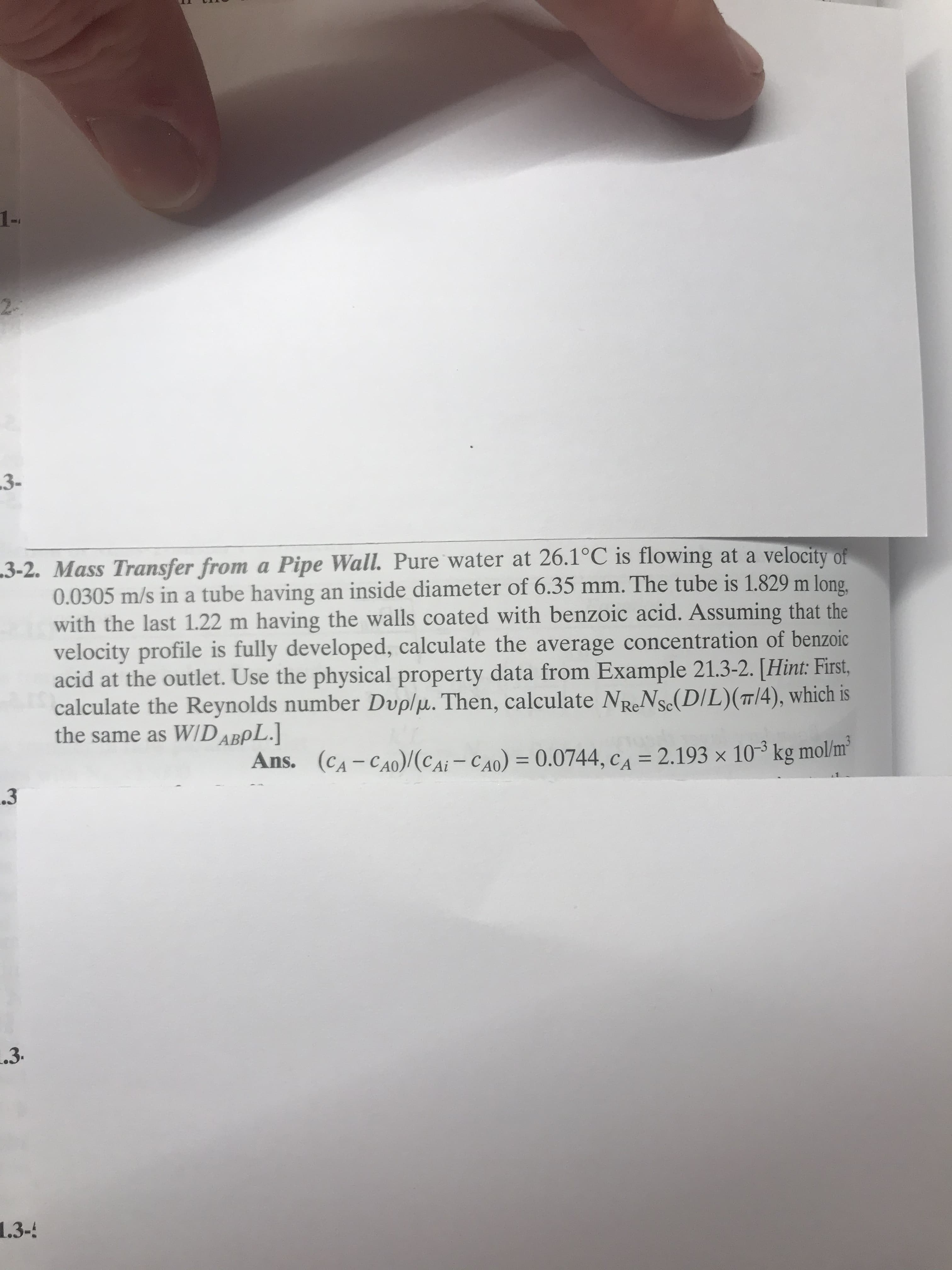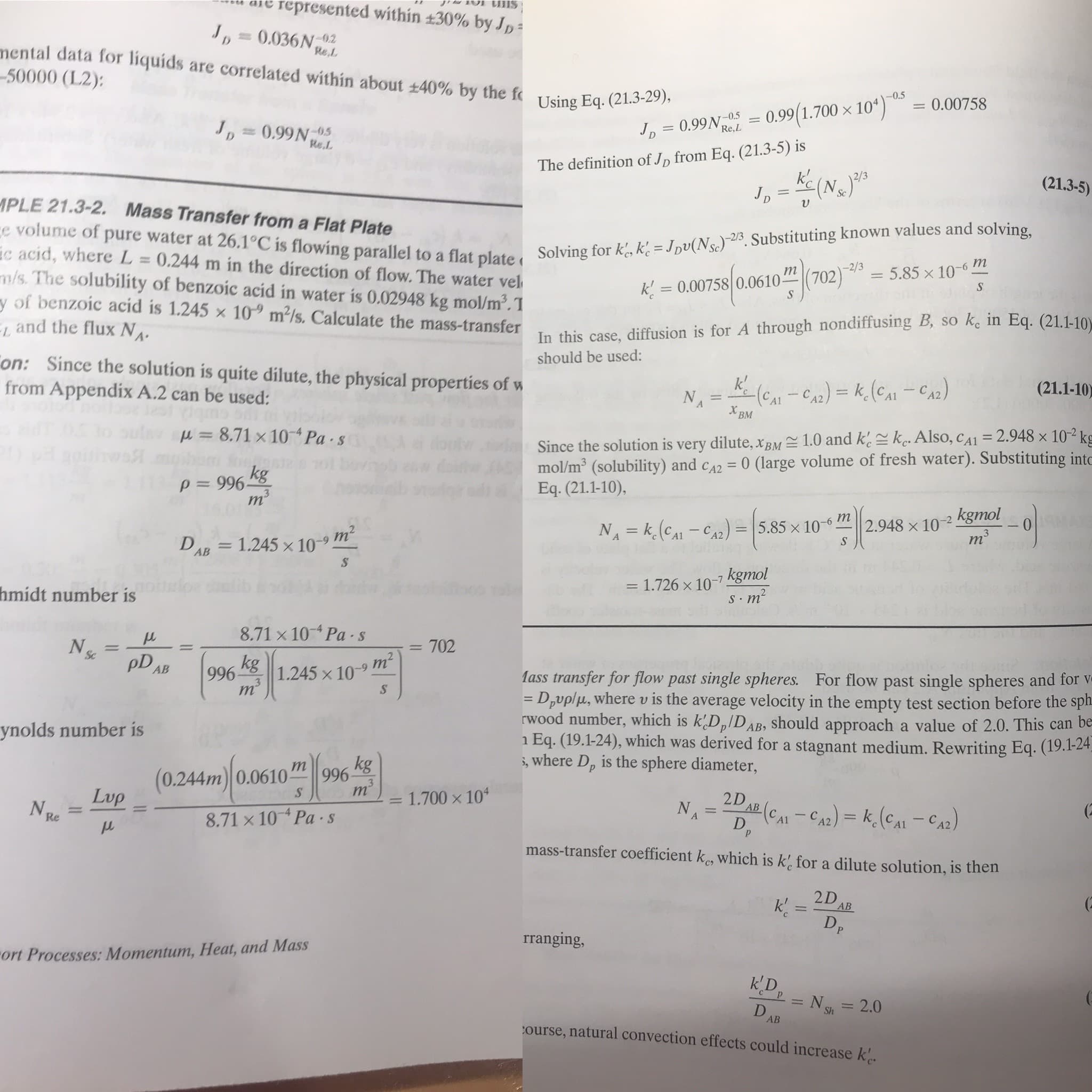1M 3- 3-2. Mass Transfer from a Pipe Wall. Pure water at 26.1°C is flowing at a velocity of 0.0305 m/s ina tube having an inside diameter of 6.35 mm. The tube is 1.829 m long with the last 1.22 m having the walls coated with benzoic acid. Assuming that the velocity profile is fully developed, calculate the average concentration of benzoic acid at the outlet. Use the physical property data from Example 21.3-2. [Hint: First, calculate the Reynolds number Duplu. Then, calculate NReNse(D/L) (T/4), which is the same as WIDABPL. Ans. (CA-CAO)/(CAi-CAO) = 0.0744, cA 2.193 x 103 kg mol/m .3 .3 1.3- represented within +30 % by Jp Sm JD0.036N2 mental data for liquids are correlated within about +40% by the f -50000 (L2): Re,L -0.5 Using Eq. (21.3-29), 0.00758 0.99(1.700 x 10 Jp 0.99N05 JD0.99N0.5 Re,L Re.L The definition of Jp from Eq. (21.3-5) is ke(Ne (21.3-5) MPLE 21.3-2. Mass Transfer from a Flat Plate e volume of pure water at 26.1°C is flowing parallel to a flat plate Solving for ke k= Jpv(Nc)2. Substituting known values and solving, ic acid, where L 0.244 m in the direction of flow. The water vel m/s. The solubility of benzoic acid in water is 0.02948 kg mol/m2. 5.85 x 10-6 m S -2/3 k0.00758 0.0610 S y of benzoic acid is 1.245 x 10 m2/s. Calculate the mass-transfer In this case, diffusion is for A through nondiffusing B, so k, in Eq. (21.1-10) and the flux NA on: Since the solution is quite dilute, the physical properties of w from Appendix A.2 can be used: should be used: (e-CA)= k (eA-C2) Х вм (21.1-10) A Cubp 8.71 x 10 Pa s 1.0 and keke Also, cA1 = 2.948 x 10-2 ks 0 (large volume of fresh water). Substituting into Since the solution is very dilute, XBM mol/m3 (solubility) and CA2 Eq. (21.1-10), P 996 kg m3 kgmol т 2.948 x 10 0 NA k.(CAI-CA2) = |5.85 x 10-6 m3 m2 DAR 1.245 x 10 S -9 1.726 x 10-7 kgmol S.m2 hmidt number is 8.71 x 10 Pa s No 702 Sc kg 996 m3 pD d mte m2 AB 1.245 x 10-9 Mass transfer for flow past single spheres. For flow past single spheres and for v = D,uplu, where v is the average velocity in the empty test section before the sph rwood number, which is k'D,/DAB, should approach a value of 2.0. This can be Eq. (19.1-24), which was derived for a stagnant medium. Rewriting Eq. (19.-24. ,where Dp is the sphere diameter, ynolds number is kg (0.244m 0.0610 Lup 996 m2 1.700 x 10 2D AB NA CA-CA)= k(CA- CA2) 8.71x 10 Pa -s Re mass-transfer coefficient ke, which is k' for a dilute solution, is then 2D АВ DP Irranging, ort Processes: Momentum, Heat, and Mass P N 2.0 D АВ Sh ourse, natural convection effects could increase k..
1M 3- 3-2. Mass Transfer from a Pipe Wall. Pure water at 26.1°C is flowing at a velocity of 0.0305 m/s ina tube having an inside diameter of 6.35 mm. The tube is 1.829 m long with the last 1.22 m having the walls coated with benzoic acid. Assuming that the velocity profile is fully developed, calculate the average concentration of benzoic acid at the outlet. Use the physical property data from Example 21.3-2. [Hint: First, calculate the Reynolds number Duplu. Then, calculate NReNse(D/L) (T/4), which is the same as WIDABPL. Ans. (CA-CAO)/(CAi-CAO) = 0.0744, cA 2.193 x 103 kg mol/m .3 .3 1.3- represented within +30 % by Jp Sm JD0.036N2 mental data for liquids are correlated within about +40% by the f -50000 (L2): Re,L -0.5 Using Eq. (21.3-29), 0.00758 0.99(1.700 x 10 Jp 0.99N05 JD0.99N0.5 Re,L Re.L The definition of Jp from Eq. (21.3-5) is ke(Ne (21.3-5) MPLE 21.3-2. Mass Transfer from a Flat Plate e volume of pure water at 26.1°C is flowing parallel to a flat plate Solving for ke k= Jpv(Nc)2. Substituting known values and solving, ic acid, where L 0.244 m in the direction of flow. The water vel m/s. The solubility of benzoic acid in water is 0.02948 kg mol/m2. 5.85 x 10-6 m S -2/3 k0.00758 0.0610 S y of benzoic acid is 1.245 x 10 m2/s. Calculate the mass-transfer In this case, diffusion is for A through nondiffusing B, so k, in Eq. (21.1-10) and the flux NA on: Since the solution is quite dilute, the physical properties of w from Appendix A.2 can be used: should be used: (e-CA)= k (eA-C2) Х вм (21.1-10) A Cubp 8.71 x 10 Pa s 1.0 and keke Also, cA1 = 2.948 x 10-2 ks 0 (large volume of fresh water). Substituting into Since the solution is very dilute, XBM mol/m3 (solubility) and CA2 Eq. (21.1-10), P 996 kg m3 kgmol т 2.948 x 10 0 NA k.(CAI-CA2) = |5.85 x 10-6 m3 m2 DAR 1.245 x 10 S -9 1.726 x 10-7 kgmol S.m2 hmidt number is 8.71 x 10 Pa s No 702 Sc kg 996 m3 pD d mte m2 AB 1.245 x 10-9 Mass transfer for flow past single spheres. For flow past single spheres and for v = D,uplu, where v is the average velocity in the empty test section before the sph rwood number, which is k'D,/DAB, should approach a value of 2.0. This can be Eq. (19.1-24), which was derived for a stagnant medium. Rewriting Eq. (19.-24. ,where Dp is the sphere diameter, ynolds number is kg (0.244m 0.0610 Lup 996 m2 1.700 x 10 2D AB NA CA-CA)= k(CA- CA2) 8.71x 10 Pa -s Re mass-transfer coefficient ke, which is k' for a dilute solution, is then 2D АВ DP Irranging, ort Processes: Momentum, Heat, and Mass P N 2.0 D АВ Sh ourse, natural convection effects could increase k..
Introduction to Chemical Engineering Thermodynamics
8th Edition
ISBN:9781259696527
Author:J.M. Smith Termodinamica en ingenieria quimica, Hendrick C Van Ness, Michael Abbott, Mark Swihart
Publisher:J.M. Smith Termodinamica en ingenieria quimica, Hendrick C Van Ness, Michael Abbott, Mark Swihart
Chapter1: Introduction
Section: Chapter Questions
Problem 1.1P
Related questions
Question
100%

Transcribed Image Text:1M
3-
3-2. Mass Transfer from a Pipe Wall. Pure water at 26.1°C is flowing at a velocity of
0.0305 m/s ina tube having an inside diameter of 6.35 mm. The tube is 1.829 m long
with the last 1.22 m having the walls coated with benzoic acid. Assuming that the
velocity profile is fully developed, calculate the average concentration of benzoic
acid at the outlet. Use the physical property data from Example 21.3-2. [Hint: First,
calculate the Reynolds number Duplu. Then, calculate NReNse(D/L) (T/4), which is
the same as WIDABPL.
Ans.
(CA-CAO)/(CAi-CAO) = 0.0744, cA 2.193 x 103 kg mol/m
.3
.3
1.3-

Transcribed Image Text:represented within +30 % by Jp
Sm
JD0.036N2
mental data for liquids are correlated within about +40% by the f
-50000 (L2):
Re,L
-0.5
Using Eq. (21.3-29),
0.00758
0.99(1.700 x 10
Jp 0.99N05
JD0.99N0.5
Re,L
Re.L
The definition of Jp from Eq. (21.3-5) is
ke(Ne
(21.3-5)
MPLE 21.3-2.
Mass Transfer from a Flat Plate
e volume of pure water at 26.1°C is flowing parallel to a flat plate Solving for ke k= Jpv(Nc)2. Substituting known values and solving,
ic acid, where L 0.244 m in the direction of flow. The water vel
m/s. The solubility of benzoic acid in water is 0.02948 kg mol/m2.
5.85 x 10-6 m
S
-2/3
k0.00758 0.0610
S
y of benzoic acid is 1.245 x 10 m2/s. Calculate the mass-transfer In this case, diffusion is for A through nondiffusing B, so k, in Eq. (21.1-10)
and the flux NA
on: Since the solution is quite dilute, the physical properties of w
from Appendix A.2 can be used:
should be used:
(e-CA)= k (eA-C2)
Х вм
(21.1-10)
A
Cubp
8.71 x 10 Pa s
1.0 and keke Also, cA1 = 2.948 x 10-2 ks
0 (large volume of fresh water). Substituting into
Since the solution is very dilute, XBM
mol/m3 (solubility) and CA2
Eq. (21.1-10),
P 996 kg
m3
kgmol
т
2.948 x 10
0
NA k.(CAI-CA2) = |5.85 x 10-6
m3
m2
DAR 1.245 x 10
S
-9
1.726 x 10-7 kgmol
S.m2
hmidt number is
8.71 x 10 Pa s
No
702
Sc
kg
996
m3
pD
d mte
m2
AB
1.245 x 10-9
Mass transfer for flow past single spheres. For flow past single spheres and for v
= D,uplu, where v is the average velocity in the empty test section before the sph
rwood number, which is k'D,/DAB, should approach a value of 2.0. This can be
Eq. (19.1-24), which was derived for a stagnant medium. Rewriting Eq. (19.-24.
,where Dp is the sphere diameter,
ynolds number is
kg
(0.244m 0.0610
Lup
996
m2
1.700 x 10
2D
AB
NA
CA-CA)= k(CA- CA2)
8.71x 10 Pa -s
Re
mass-transfer coefficient ke, which is k' for a dilute solution, is then
2D
АВ
DP
Irranging,
ort Processes: Momentum, Heat, and Mass
P N 2.0
D
АВ
Sh
ourse, natural convection effects could increase k..
Expert Solution
Trending now
This is a popular solution!
Step by step
Solved in 9 steps with 8 images

Recommended textbooks for you

Introduction to Chemical Engineering Thermodynami…
Chemical Engineering
ISBN:
9781259696527
Author:
J.M. Smith Termodinamica en ingenieria quimica, Hendrick C Van Ness, Michael Abbott, Mark Swihart
Publisher:
McGraw-Hill Education

Elementary Principles of Chemical Processes, Bind…
Chemical Engineering
ISBN:
9781118431221
Author:
Richard M. Felder, Ronald W. Rousseau, Lisa G. Bullard
Publisher:
WILEY

Elements of Chemical Reaction Engineering (5th Ed…
Chemical Engineering
ISBN:
9780133887518
Author:
H. Scott Fogler
Publisher:
Prentice Hall

Introduction to Chemical Engineering Thermodynami…
Chemical Engineering
ISBN:
9781259696527
Author:
J.M. Smith Termodinamica en ingenieria quimica, Hendrick C Van Ness, Michael Abbott, Mark Swihart
Publisher:
McGraw-Hill Education

Elementary Principles of Chemical Processes, Bind…
Chemical Engineering
ISBN:
9781118431221
Author:
Richard M. Felder, Ronald W. Rousseau, Lisa G. Bullard
Publisher:
WILEY

Elements of Chemical Reaction Engineering (5th Ed…
Chemical Engineering
ISBN:
9780133887518
Author:
H. Scott Fogler
Publisher:
Prentice Hall


Industrial Plastics: Theory and Applications
Chemical Engineering
ISBN:
9781285061238
Author:
Lokensgard, Erik
Publisher:
Delmar Cengage Learning

Unit Operations of Chemical Engineering
Chemical Engineering
ISBN:
9780072848236
Author:
Warren McCabe, Julian C. Smith, Peter Harriott
Publisher:
McGraw-Hill Companies, The